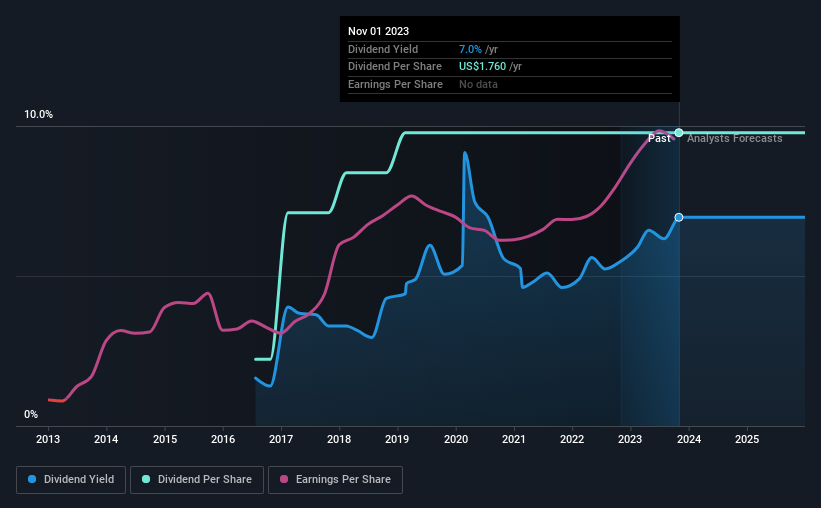The Bank of N.T. Butterfield & Son Limited (NYSE:NTB) Looks Interesting, And It's About To Pay A Dividend
Regular readers will know that we love our dividends at Simply Wall St, which is why it's exciting to see The Bank of N.T. Butterfield & Son Limited (NYSE:NTB) is about to trade ex-dividend in the next four days. The ex-dividend date is one business day before the record date, which is the cut-off date for shareholders to be present on the company's books to be eligible for a dividend payment. The ex-dividend date is an important date to be aware of as any purchase of the stock made on or after this date might mean a late settlement that doesn't show on the record date. In other words, investors can purchase Bank of N.T. Butterfield & Son's shares before the 7th of November in order to be eligible for the dividend, which will be paid on the 22nd of November.
The company's next dividend payment will be US$0.44 per share, and in the last 12 months, the company paid a total of US$1.76 per share. Based on the last year's worth of payments, Bank of N.T. Butterfield & Son stock has a trailing yield of around 7.0% on the current share price of $25.3. If you buy this business for its dividend, you should have an idea of whether Bank of N.T. Butterfield & Son's dividend is reliable and sustainable. So we need to check whether the dividend payments are covered, and if earnings are growing.
Check out our latest analysis for Bank of N.T. Butterfield & Son
Dividends are typically paid from company earnings. If a company pays more in dividends than it earned in profit, then the dividend could be unsustainable. That's why it's good to see Bank of N.T. Butterfield & Son paying out a modest 37% of its earnings.
When a company paid out less in dividends than it earned in profit, this generally suggests its dividend is affordable. The lower the % of its profit that it pays out, the greater the margin of safety for the dividend if the business enters a downturn.
Click here to see the company's payout ratio, plus analyst estimates of its future dividends.
Have Earnings And Dividends Been Growing?
Companies with consistently growing earnings per share generally make the best dividend stocks, as they usually find it easier to grow dividends per share. If earnings decline and the company is forced to cut its dividend, investors could watch the value of their investment go up in smoke. Fortunately for readers, Bank of N.T. Butterfield & Son's earnings per share have been growing at 12% a year for the past five years.
Many investors will assess a company's dividend performance by evaluating how much the dividend payments have changed over time. Bank of N.T. Butterfield & Son has delivered 24% dividend growth per year on average over the past seven years. Both per-share earnings and dividends have both been growing rapidly in recent times, which is great to see.
The Bottom Line
Is Bank of N.T. Butterfield & Son worth buying for its dividend? Companies like Bank of N.T. Butterfield & Son that are growing rapidly and paying out a low fraction of earnings, are usually reinvesting heavily in their business. This is one of the most attractive investment combinations under this analysis, as it can create substantial value for investors over the long run. We think this is a pretty attractive combination, and would be interested in investigating Bank of N.T. Butterfield & Son more closely.
On that note, you'll want to research what risks Bank of N.T. Butterfield & Son is facing. Every company has risks, and we've spotted 2 warning signs for Bank of N.T. Butterfield & Son (of which 1 is significant!) you should know about.
A common investing mistake is buying the first interesting stock you see. Here you can find a full list of high-yield dividend stocks.
Have feedback on this article? Concerned about the content? Get in touch with us directly. Alternatively, email editorial-team (at) simplywallst.com.
This article by Simply Wall St is general in nature. We provide commentary based on historical data and analyst forecasts only using an unbiased methodology and our articles are not intended to be financial advice. It does not constitute a recommendation to buy or sell any stock, and does not take account of your objectives, or your financial situation. We aim to bring you long-term focused analysis driven by fundamental data. Note that our analysis may not factor in the latest price-sensitive company announcements or qualitative material. Simply Wall St has no position in any stocks mentioned.

